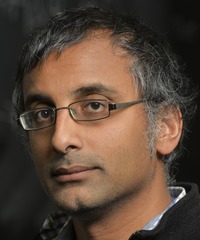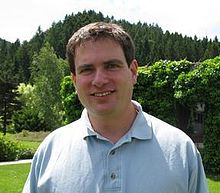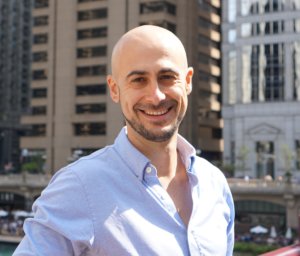
Winners of Prestigious Math Prize Team Up
BSF grant brings together award-winning mathematicians and a rising Israeli star

As two respected figures in the mathematics world, Elon Lindenstrauss and Akshay Venkatesh have known and collaborated with one another for many years. When they expressed interest in working together once more, they knew that a BSF grant would provide, as Lindenstrauss put it, “a good excuse to collaborate again.”
Lindenstrauss is a professor at Hebrew University’s Mathematics Institute. For him, math runs in the family. His father, the late Joram Lindenstrauss, was a prominent Israeli mathematician who received six BSF grants throughout his career – grants that helped support partnerships with prominent mathematicians in the United States.
“My father had very important collaborations with many people throughout his career, and his partnerships with colleagues in the United States were especially important to him,” Lindenstrauss said.

There was another reason to apply for a BSF grant: it would also provide a framework for Lindenstrauss and Venkatesh to work with a promising young Israeli mathematician who is currently teaching in the United States. Dr. Ilya Khayutin is a graduate of Hebrew University — and a former PhD student of Lindenstrauss’s. Khayutin, now an assistant professor of mathematics at Northwestern University, is a lead investigator on the current project along with Lindenstrauss and Venkatesh.
“Ilya has a deep understanding of what we are trying to accomplish, and I know he will play an important role in this effort,” Lindenstrauss said.
As for Khayutin, he is glad to be a partner with someone who directly influenced his mathematic studies.
“When I was a student, Elon had a great effect on me. Beyond the textbook interactions between an advisor and a student, I learned a lot from Elon about what constitutes good mathematics,” Khayutin said.

Khayutin had opportunities to learn from Venkatesh as well — first when he participated in a semester-long program at the Mathematical Sciences Research Institute in Berkeley, and again when he was a postdoc at Princeton. Venkatesh is a professor at Princeton’s Institute for Advanced Study.
“Akshay, in his work and in several high impact collaborations, has been able to see deeper into many questions in analytic number theory and to discover in them the fundamental role of ergodic theory. This really has constructed a bridge to number theory for people like myself,” Khayutin said.
Like Lindenstrauss, Venkatesh is also impressed with young Khayutin.
“I’ve known Ilya for a few years,” Venkatesh said. “I was quite surprised by the clarity which he brought to things that I had thought about previously. In his work as a postdoc, Ilya made a breakthrough on a conjecture of mine and Philippe Michell. This was completely fearless and really impressed me. I would never have suggested this problem to work on, since it seemed too hard!”
Their BSF-supported project involves the arithmetic, algebraic and high dimensional aspects of homogeneous dynamics. In the 19th century, the mathematician Hermann Minkowski discovered that certain problems in number theory can be encoded geometrically in terms of lattices (that is, regularly spaced grids of points) in Euclidean space. This method is known as the geometry of numbers.
In the last 30 years or so, ergodic theory has been introduced into the geometry of numbers. Ergodic theory has its origins in attempts to study the evolution of the solar system, as well as other systems where the dynamics are too complicated to be solved explicitly.
With this project, Lindenstrauss, Venkatesh and Khayutin hope to shed more light on natural number theoretic problems at the interface between ergodic theory and the geometry of numbers. They also hope to gain a better understanding of the geometry of the space of lattices in high dimensions, and a picture of what a “random” high dimensional lattice looks like.
“Many mathematics projects involve study of low-dimension lattices, so we hope to expand what is known about high dimension lattices,” Lindenstrauss said.
Lindenstrauss specializes in the study of ergodic theory, while Venkatesh focuses on topics at the interface between number theory and other fields, including representation theory, dynamics, and algebraic topology. They have known each other for 15 years. They are both winners of the Fields Medal, which has been called the Nobel Prize for young mathematicians. The Fields Medal is as rare as it is prestigious. It is awarded only once every four years, at the International Congress of Mathematicians. Even then, only two, three, or four recipients from nations throughout the world are selected.
Venkatesh won the Medal in 2018. Lindenstrauss was honored in 2010. So far, he is the only Israeli to receive the Medal.
While both are honored to be among the recipients, Lindenstrauss said the recognition does not mean as much as the ability to come up with innovative ideas.
“Mathematics is a fairly democratic field,” Lindenstrauss said. “You need good ideas, and it does not matter whether they come from award-winning mathematicians, or from promising newcomers. If you have a good idea and show how you can make it work, you can change the direction of the subject.”
Venkatesh also has mixed feelings about awards, though he admits he has, “gotten probably more than my fair share of them.”
“To me, a lot of the fun of mathematics comes from collaborating,” Venkatesh said. “This is why I am very happy to be working with Elon and Ilya. My hope for this collaboration is that we start discussing some problems associated with high-dimensional lattices. These problems have been studied primarily in computer science, and I’m hoping that — between the three of us — we can bring some new tools to bear on them.”
